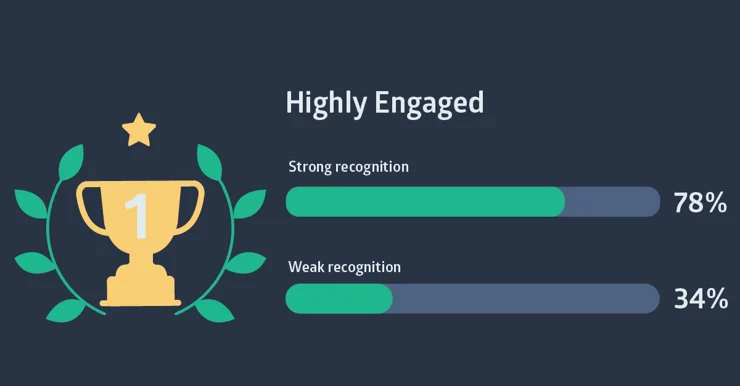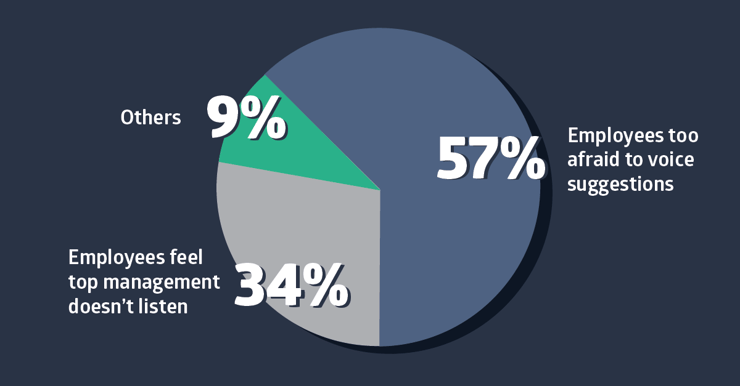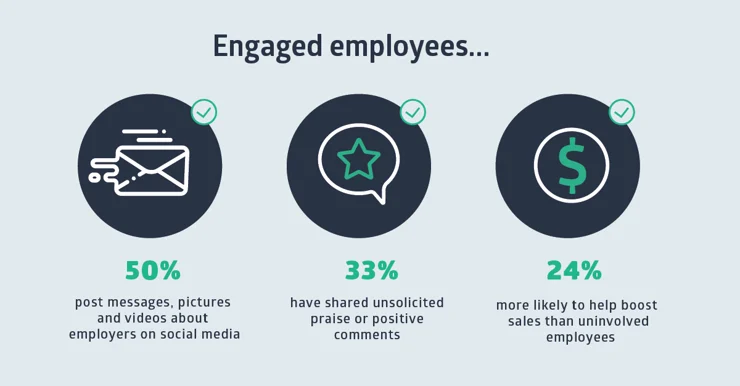3 Ways Internal Communications Can Drive Employee Engagement

Transparency and openness are fundamental for internal communication: they have a huge impact on your employees’ perception of your company and thus on the way they feel and perform at work. If you’re looking to up your internal communications game, here are three ideas for you to implement that will positively impact the overall employee engagement levels in your company.

The conversation about the engagement of the workforce has been getting louder. At Ambassify, we’re working with companies dismantling and rebuilding their internal processes to address the productivity and well-being issues that stem from an uninspired and disengaged workforce.
Sometimes, the problem is the employee — they are not a good fit for their role. Other times, the problem lies solely with the company — no effort is to acknowledge poor engagement or deal with it.
However, in most cases, assigning blame is not as straightforward because the real problem is not engagement — it’s communication. Most companies don’t know how to communicate with their employees the right way. This creates huge business problems, of course, because efficient and transparent internal communication is vital to business success.
Internal communication affects every aspect of a company — from engagement and productivity to employee advocacy and brand perception. Rachel Miller, a renowned expert in the field, offers a deceptively simplistic definition of it:
“Internal communications is the way that a company interacts with its people and they interact with it.”
The keyword here is interaction. Much like our daily personal interactions shape our life, our business interactions shape our motivation, productivity, drive, and engagement at work.
If these interactions are not easy, efficient, targeted, and positive, they negatively affect engagement levels across the whole organization. The role of internal communication is to create shared understanding and meaning by enabling two-way conversations. Only then can employees efficiently work toward company goals.
Recognize individual achievements in an open forum

One of the most effective ways to boost employee engagement is to recognize and reward your top performers. Multiple studies report that only a tiny percentage of employees feel rewarded for a job well done. That’s a missed opportunity if there ever was one — telling someone that they’ve done an excellent job costs nothing, but it can have a measurable impact on their productivity. We even wrote a separate article specifically on the topic of how you can be measuring employee engagement more closely.

Source: O.C.Tanner Institute
One way internal communicators can take this to a whole new level is by providing employees with a platform that has an integrated recognition feature. That way, managers and department heads can regularly recognize job excellence in a public forum, which amplifies the effect, instead of just doing it once a year during performance reviews.
Additionally, all employees can use it to express their gratitude to peers that have in some way contributed to their projects.
While harping on about recognition seems offensive in its simplicity, the fact of the matter is that many managers still fail to execute it. That’s why the importance of recognition needs to be baked into internal comms procedures and processes, to shine a spotlight on it constantly. This won’t turn every manager in your company into a recognition-focused superstar, but it’s a great start.
Encourage transparency and discussion
 Organizational transparency has long been a controversial topic in management circles.
Organizational transparency has long been a controversial topic in management circles.
How much do your employees need to know to do their job well? We subscribe to the school of thought that says that they need to know a lot — after all, it’s their work making money for the company. Isn’t it only fair that top management returns the favor by being open and honest about the decisions that are being made or are in the works?
- Organizational transparency is ethical. Some studies find it a vital building block of an engaged workforce. Employees are genuinely more engaged in their job when they don’t suspect that they’re being kept in the dark.
- Organizational transparency is the key to engaged employees. As an internal communicator, we want you to go a step further and provide employees with a forum to discuss company information openly and honestly. Otherwise, you’re creating a community of yes-man employees who will not challenge any decision put in front of them.
For example, think of working hours. If you're choosing to leave your employees flexible working hours, be explicit about it. Tell them what that actually entails and how they are supposed to manage their own time.
Or you could instead decide to track employee hours to be able to better track their work and productivity, for example, to build reports for partners or clients. In that case, be transparent about it too. Give them one place to record and track their hours, so you can better keep track of it, and there is a clearer attribution process in place, for example, with an app.
And even though it might sound slightly appealing just to have people do what they are told, what it will lead to in the long run is an unimaginative environment that leads to stagnancy.
Encouraging discussion and dissent might seem controversial, but, as Amy Gallo writes1, it can be a boon for your organization. During her research, she has found that companies that allow for radical transparency and disagreement reap several benefits, including better work outcomes, new opportunities for employees to learn and grow, improved relationships, higher job satisfaction, and an inclusive and diverse work environment.
Incidentally, these are all things that increase overall employee engagement so, when done right, it’s a win on many different fronts. Again, practicing openness and transparency, and encouraging employees to voice opinions doesn’t cost a thing — it is an adjustment to company culture. Still, it’s an adjustment that will pay out dividends for years into the future.
Solicit feedback and act on it

Although one of the roles of internal communications is to create processes that make it easy to disseminate accurate and targeted information to employees, even comms professionals often forget that ‘real’ communication is a two-way street.
There’s nothing more frustrating to employees than finding out that, despite the “we listen to our employees” prominently featured in its values manifesto, the top management is completely deaf when it comes to constructive criticism and employee feedback. And, you’d be surprised to find out exactly how many employees within your own company may be, actually do feel like that.

Ask your employees about how they feel their role could be improved and their contribution enhanced, or what they think about the new paternity leave policy that the HR department is considering. Do it often, and use every appropriate channel — pulse surveys, engagement platforms, email, intranet, polls, and face-to-face conversations. But don’t invalidate all that work by collecting the responses and sticking them in a cabinet to collect dust.
Asking for feedback and ignoring it is the most obvious way of telling your employees that their opinions don’t count for anything. Once they realize that, you’ve ruined every chance of creating and sustaining highly engaged teams in the future.
Obviously, as a company, you can’t just do everything that your employees ask you to, and you can’t make concessions. But when it comes to building a work environment that encourages and stimulates the employees to work at their best, it’s vital that suggestions are listened to and taken into consideration to make improvements.
Internal communication officers can’t strong-arm the leadership into considering employee proposals. However, what they can do is codify policies and procedures that relate to them. They can create rules that outline how employees submit their suggestions and feedback and how managers are expected to respond.
In and of themselves, these rules will encourage employees to voice opinions without worrying that it’s a ‘screaming into the void’ exercise. On the other hand, managers will have guidelines on how to respond respectfully to suggestions that they decline and how to fight for the ones they believe are worth the company's time and effort.
Engaged employees are your most efficient salesforce
Engaged employees are (usually) happy employees. To become a source of happiness for every person who walks through the doors of your company at 8 AM is an admirable accomplishment.
But, it’s also a difficult sell to company stakeholders, especially when money is being spent on initiatives that contribute to that happiness. We get that.
Here’s a ‘bottom line’ reason why investing in internal communications and employee engagement makes sense — not only are engaged employees more productive and more likely to stay with you, but they’re also your most effective advocates and salespeople.

Whether we’re talking social promotion, word-of-mouth marketing, or general unsolicited PR, it’s your engaged employees that have your back. They’ll spontaneously praise the company when barbecuing with friends or rush to its defense when it’s tarnished on social media. No amount of money can buy that kind of devotion.
It needs to be earned, and one way to do so is to tailor internal comms processes to be conducive to a company culture that promotes high-performing engagement.
Ambassify is a platform that provides you with the tools to communicate more effectively internally and has additional modules that support ongoing employee engagement and advocacy activities!
Book a demo